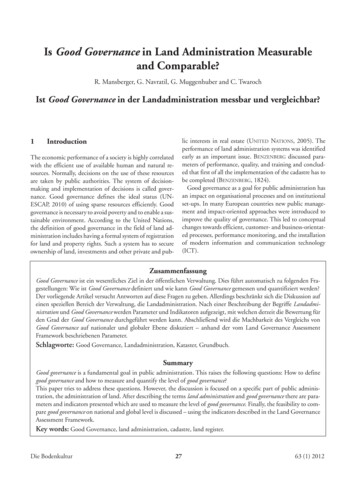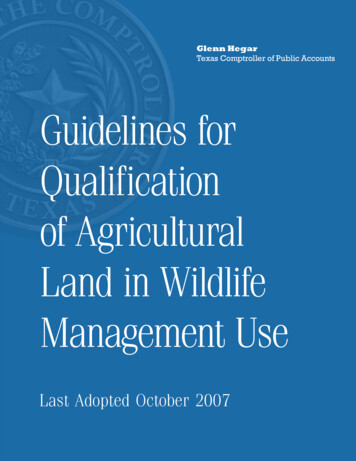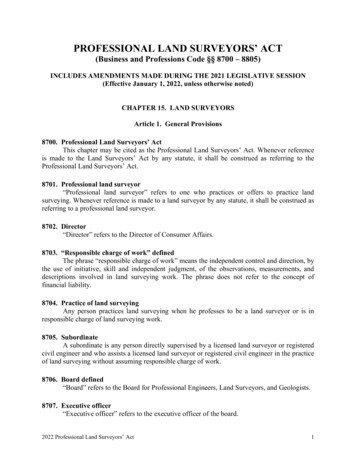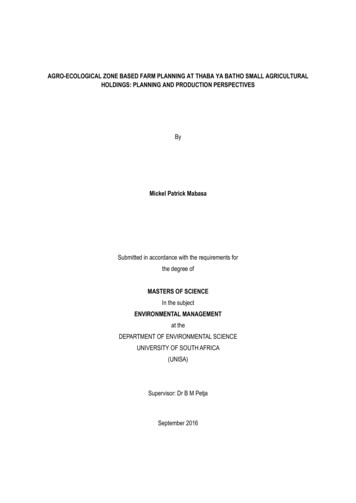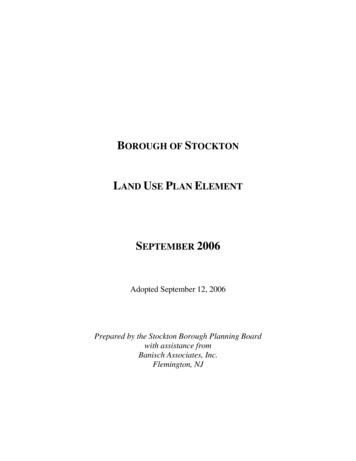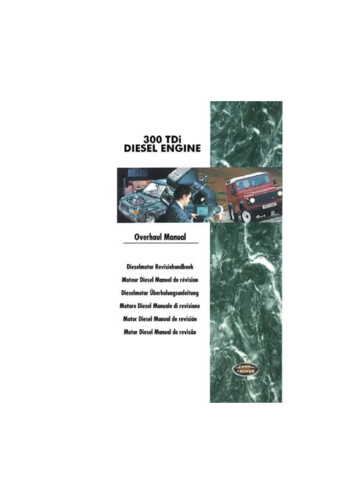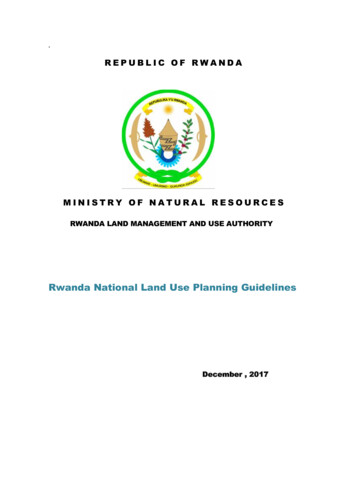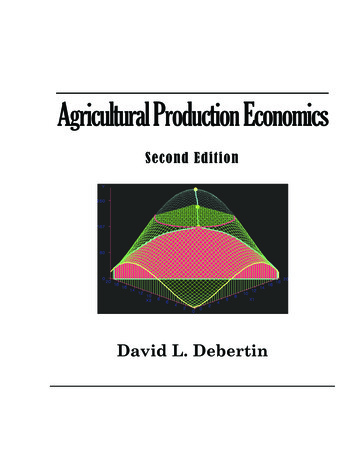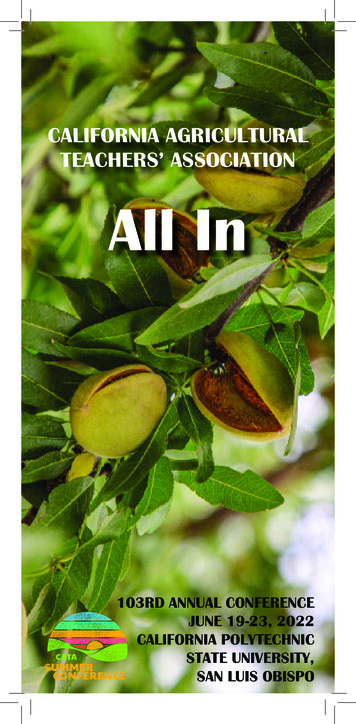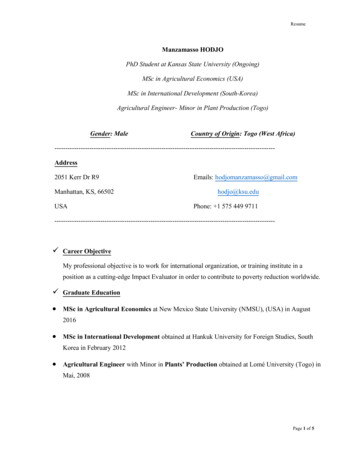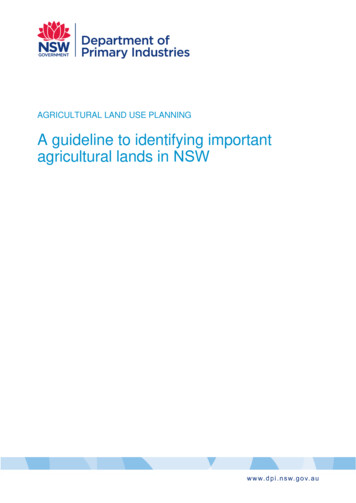
Transcription
AGRICULTURAL LAND USE PLANNINGA guideline to identifying importantagricultural lands in NSW
Published by the NSW Department of Primary IndustriesA guideline to identifying important agricultural lands in NSW.First published April 2017ISBN 978-1-76058-010-0Wendy Goodburn, Agricultural Land Use Planning Unit, South East Region.www.dpi.nsw.gov.auCover image: Important grazing and cropping land in the Blayney, Orange and Cabonne local government areas, NSW Departmentof Primary Industries, 2012.[Pub16/323] State of New South Wales through the Department of Industry, Skills and Regional Development, 2017. You may copy, distribute and otherwise freelydeal with this publication for any purpose, provided that you attribute the NSW Department of Primary Industries as the owner.Disclaimer: The information contained in this publication is based on knowledge and understanding at the time of writing (April 2017). However,because of advances in knowledge, users are reminded of the need to ensure that information upon which they rely is up to date and to check currencyof the information with the appropriate officer of the Department of Primary Industries or the user’s independent adviser.
AcknowledgementsThe guideline was developed with contributions from: Glenda Briggs, Communication and Engagement, NSW Department of Industry, GreaterHunter/ Sydney Region, Azaria Dobson, Acting Director, NSW DPE, Western Region, Mary Kovac, Resource Management Officer, NSW DPI, Central-Western Region, Liz Rogers, Manager, Agricultural Land Use Planning, NSW DPI, Orange, Nita Scott, Senior Planner, Western Region, NSW DPE, Helen Squires, Resource Management Officer, NSW DPI, Hunter Region.Thanks also to the following people for their considered input: Andrew Docking, Resource Management Officer, NSW DPI, Sydney Region,Rebekah Gomez-Forte, Manager, Planning Policy, Planning Policy and AssessmentAdvice, NSW DPI, Robyn Hean, Manager, Economic Research, Economics and Analysis, NSW DPI, Simon Holloway, Environmental Services Co-ordinator, Queanbeyan-Palerang RegionalCouncil, Brian Jenkins, Senior Team Leader – Assessment, Science Division, NSW OEH, Vanessa John, Environmental Strategy Officer, Wollongong City Council, Kate Johnson, Policy Officer, Planning Policy, Planning Policy and Assessment Advice,NSW DPI, Melissa Kahler, Resource Management Officer, North-Coast Region, NSW DPI, Mathew Miles, Principal Advisor, Environmental Information, South Australia Departmentof Environment, Water and Natural Resources, Humphrey Milford, Acting Senior Team Leader, Assessment, Ecosystem ManagementScience, NSW OEH, Lilian Parker, Resource Management Officer, NSW DPI, Western NSW, Ian Rankin, Senior Strategic Planner, Shellharbour City Council, Sue Robb, Strategic Planning Co-ordinator, Queanbeyan-Palerang Regional Council, Fiona Scott, Senior Economist, Economics and Analysis, NSW DPI, Dr Jane Stewart, Director, Land Use and Management, Fisheries, Forestry andQuantitative Sciences, ABARES, Rob Williamson, Leader, Agricultural Land Use Planning, NSW DPI, Bill Williamson, Resource Management Officer, NSW DPI, Sydney region.The Catchment Action NSW 2011/2012 program provided the funding for the NSW DPI pilotmapping project (pilot project).Special acknowledgement to Peter Worsley, Project Officer, Emergency Operations, Intelligenceand Programs, NSW DPI, for developing the maps for the pilot project.Special acknowledgement also to Richard Hicks, Senior Team Leader and Stuart Smith, SeniorScientist, Remote Sensing and Analysis, Science Division, NSW OEH for the provision ofmapping data for the pilot project and their advice on data usage.
A Method for Identifying Important Agricultural Lands in NSWAbbreviationsACSAgriculture commodity surveyABARESAustralian Bureau of Agricultural and Resource Economics and Sciences.ABSAustralian Bureau of StatisticsAIPAgricultural industry profilesALCAgricultural land classificationALUMAustralian land use and management classification.ARMSAgriculture resource management surveyBSALBiophysical strategic agricultural landCICCritical industry clustersIALImportant agricultural landLEPLocal environmental planLGALocal government areaLSCLand and soil capabilityLUMAPNSW land use mapping programMCAS-SMulti-Criteria Analysis Shell for Spatial Decision Support software toolNSW DIPNR NSW Department of Infrastructure, Planning and Natural ResourcesNSW DoPNSW Department of PlanningNSW DPENSW Department of Planning and EnvironmentNSW DP&INSW Department of Planning and InfrastructureNSW DPINSW Department of Primary IndustriesNSW OEHNSW Office of Environment and HeritagePilot projectNSW DPI pilot mapping projectREACSRural Environment and Agriculture Commodity SurveyRLCRural land capabilitySALStrategic agricultural landSCALDNSW standard classification for attributes of landWMAWater Management Act 2000WAWater Act 1912iiNSW DPI, December 2016
A Method for Identifying Important Agricultural Lands in NSWForewordPlanning for rural land requires a clear understanding not only of the biophysical resources andclimate, but also the nature and extent of enterprises, the contribution made by farming, and thelocation of important infrastructure and value adding industries.Rural land supports primary production that also includes forestry, mining and energy generation(wind, geothermal and solar farms). There are also demands on rural land from residentialdevelopment. In some instances, agriculture risks being disregarded for its contribution to theeconomy and social structures, and displaced by other land uses assumed to provide greaterbenefits.Governments now increasingly require an evidence base upon which to develop policy,especially land use planning. Identifying and mapping agricultural land at the local governmentand regional level provides critical information that can contribute to planning for the retentionand growth of agriculture. This information assists local and state governments, regionalplanning, and natural-resource management agencies plan for the future of rural areas.This mapping methodology helps bring together critical information to assist in land use decisionmaking for agricultural land.iiiNSW DPI, December 2016
A Method for Identifying Important Agricultural Lands in NSWTable of i1.Introduction22.Purpose of this guideline33.Background44.Defining the project55.Deciding on the important agricultural land mapping product86.Developing the project127. Product development, application to strategic planning and planning policy and riskassessment258.More information26References27Appendixes32Appendix 1 Examples of agricultural mapping approaches32Appendix 2 A review of the NSW DPI pilot mapping project 201245Appendix 3 Notes on available data sets47TablesTable 1 Relationship between scale, ground distance and area11Table 2 Useful spatial datasets for identifying important agricultural lands16Table 3 Specific additional spatial datasets used for the NSW DPI pilot mapping project in theUpper Hunter region of NSW18Table 4 Permitted and prohibited land uses for each agricultural industry in the context ofstrategic planning instruments in the Lower Hunter region of NSW39Table 5 Criteria and thresholds for mapping important poultry lands in the Lower Hunter region ofNSW41Table 6 Criteria and thresholds used for mapping important agricultural lands in the Central Westand Orana regions of NSW44FiguresFigure 1 Decision tree to identify which level to develop the IAL maps6Figure 2 Decision tree to identify the best method of mapping for a specific purpose71NSW DPI, December 2016
A Method for Identifying Important Agricultural Lands in NSW1. IntroductionRetaining land for agriculture supports sustainable regional development and food and fibreproduction and is an increasingly significant and complex issue for agricultural industries, thecommunity and government. From a global perspective, it is estimated that farmers will have toproduce 70% more food by 2050 to meet the world’s expected nine billion population (Office ofthe Director, Agricultural Development Economic Division, Economic and Social Development2009). Within Australia, continued pressure from mining and rapid urban expansion inmetropolitan, coastal and regional areas highlights the need to identify and retain important landsfor agricultural industries. There is also greater emphasis on evidence-based planning thatrequires factual information to inform local and regional strategic planning processes rather thansimply relying on popular assumptions. Collating information on agricultural industries andmapping the resources upon which they depend is the first step to providing factual information tosupport land use planning decisions.The guideline has evolved from a review of Australian and international literature and from theNSW Department of Primary Industries (NSW DPI) pilot mapping project (pilot project)undertaken within the Central tablelands and Hunter regions of NSW to identify and mapimportant agricultural land (IAL). The mapping takes into account analysis of current land uses,biophysical, socio-economic and agricultural industry approaches. The guideline explores howmapping methods can be used either individually or in combination to produce a morecomprehensive assessment. Scale is an important factor and influences the approach taken ineach situation.The guideline outlines the importance of providing clear and concise information that describesthe nature and location of agricultural land and why the land is important for agriculture andrelated industries. Mapping information includes the economic contribution, challenges andconstraints, climate change impacts, infrastructure requirements, and opportunities to providecontext critical for the interpretation and application of the information for strategic land useplanning.A significant feature of this guideline is the engagement with local producers, agriculturalspecialists and planners to obtain and verify information on agriculture in an area. The approachrecognises that agricultural industry representatives often have considerable and highly relevantlocal knowledge about important resources for agriculture, suitable locations for agriculturalindustries and the key challenges and constraints. However, this information is rarely documentedor readily available to inform evidence-based strategic planning. Collating such information andidentifying the most important resource combinations is an integral component in identifying IAL.2NSW DPI, December 2016
A Method for Identifying Important Agricultural Lands in NSW2. Purpose of this guidelineThis guideline documents the factors that should be considered when developing a map withsupporting information describing IAL. The information will assist decision makers to: develop strategic plans to retain important food and fibre production lands avoid land use conflicts and the associated community and environmental impactsparticularly in regions where competition for land is significant identify the spatial variation of the implications of climate change for agricultural industriesand provide appropriate strategic responses monitor and report on the loss of IAL, its extent and type.The guideline will help local and state governments provide information that supports strategicplanning at local, sub-regional or regional scales. When agricultural land is identified and its valueand contribution is known, informed decision making about current and future land uses canoccur.Using this guidelineInformation provided in this guideline is generic in nature and needs to be adapted to suitparticular circumstances. The guideline has been structured so that a simple or morecomprehensive approach can be implemented according to the specific needs of the project. Forinstance, the project may require only a current land use map in isolation or it may also needbiophysical or socio-economic information overlays. There may also be a need to includeagricultural industry mapping information that shows specific land requirements of agriculturalindustries.The guideline is structured into a number of parts:Part 3 provides background on the definition of IAL, methods for identifying IAL and previousapproaches.Part 4 explains what to consider when defining a project including key questions for goals andoutcomes. A decision tree (Figure 1) is provided to guideline the selection of a suitable mappingapproach.Part 5 explores the different mapping approaches including their strengths and weaknesses.Part 6 provides information on setting up the project including resources needed, defining thestudy area, stakeholder engagement, and gathering the necessary information.Part 7 outlines product development and its application for strategic planning and planning policy.Information in this document is provided to guide the user in considering an appropriate approachfor their project. However, further references and research may be required to further build theproject.3NSW DPI, December 2016
A Method for Identifying Important Agricultural Lands in NSW3. BackgroundNSW DPI recently investigated a new process for mapping important agricultural lands (IAL). Thenew mapping system needed to be: flexible enough to apply to projects with different purposes, scales, resources and timeconstraints, easily interpreted and applicable to local and regional scales to enable its input to strategicplans, local environmental plans and development control plans.Previous mapping approaches developed in the 1980s and 1990s, such as agricultural landclassification (ALC) and rural land capability (RLC) maps provided a useful summary ofbiophysical and other factors for agriculture across NSW. However, there were some limitationswith these mapping approaches including quality standards and many were unsuitable fordigitising. These maps were also not suitable for interpretation at the local or sub-regional levelbecause the scale of the underlying soil maps and they were not applicable to agriculturalactivities that are not reliant on soils such as poultry developments.These earlier approaches were developed for specific mapping outcomes and are fit for apurpose. Further information on these mapping approaches is available in Appendix 1. Thestrengths and limitations of these approaches were considered in developing this guideline andare outlined in more detail in the agricultural spatial resources guideline to be published in 2017.To guide decision making at all levels of government, IAL is defined asexisting or future location of local or regionally important agricultural industries or resources asmapped that is consistent with the NSW DPI Guideline to Identifying Important AgriculturalLands in NSW.IAL involves four mapping products that can be developed individually or in combinationdepending on your planned project outcomes. These approaches are:1. a current land use map that identifies where agricultural industries are located2. a simple map of important biophysical resources for agriculture applicable across allagricultural industries3. an additional extra overlay of socio-economic information also applicable across allagricultural industries4. an agricultural industry map that identifies the location of specific agricultural industriesusing critical biophysical criteria, access to infrastructure and socio-economic locationcriteria.Further information on the strengths and limitations of these mapping approaches is outlinedin Part 5.4NSW DPI, December 2016
A Method for Identifying Important Agricultural Lands in NSW4. Defining the projectProject purpose and defined outcomesA clear understanding of the project purpose, context and intended audience will help define themost suitable mapping approach. Project parameters must be clear and include availableresources, available data, and time frames.Project goalsThe project goals will likely reflect requirements of strategic land use planning studies which needan understanding of: accurate information on the importance of agriculture to an area and its resource needssuch as:othe extent and nature of agriculture in an areaothe contribution of agriculture in terms of commodities and per haothe infrastructure and resources required to support agriculture such as irrigationfreight, saleyards, silos, transport routesovalue adding enterprises that support agricultural producersoan area’s biophysical constraints to agriculture. trends in agriculture such as enterprise switching, intensification, increase in scale, tenure,employment future industry development needs and where to target non-agricultural land uses the risk of conflicts between agriculture and other land uses, particularly urban settlement the impact of changing climate and markets on agricultural land use what is required to retain or expand local food production (such as local, organic or nicheproducts, infrastructure, land resources, transport routes and water supply).Decision treeThe decision tree in figure 1 assists the reader to determine what project level to choose inundertaking mapping. The decision tree in figure 2 guides the reader to identify which mappingapproach to select. These decisions should be documented so the audience is clear on thedecision process and the information included in the development of the maps. Metadata shouldalso be documented as a minimum to provide clear information about the content, quality, format,location and contact information (see section 5). Any maps produced must include a clearstatement of confidence to convey to the end user the level of detail or accuracy of the map.5NSW DPI, December 2016
A Method for Identifying Important Agricultural Lands in NSWDetermining project levelWill the map be used for regionalplanning purposes only?YesNoUndertake mapping at Local orsub-regional levelUndertake mapping atregional levelStrengths: Can provide a broad regionalunderstanding of important agriculturalland.Limitations: Local detail and significancemay not be considered.Strengths: Will have information relevantto local and regional areas. This data canlater be combined to develop regionalmaps following review.Limitation: May take longer to completethe same area covered at regional level.Figure 1: Decision tree to identify which level to develop the IAL mapsNote:Local refers to a single or small group of LGAs.Sub-regional refers to a collection of LGAs with similar characteristics such as climate, topography, key agricultural industries, sharedinfrastructure.Regional refers to a large collection of LGAs typically within the NSW Planning defined regional boundaries.6NSW DPI, December 2016
A Method for Identifying Important Agricultural Lands in NSWDetermining mapping approachImportant Agricultural Land - Industries are those that are important at the local, regional or state level eithereconomically (eg gross domestic product or key niche industry) and/or socially (eg employment). Important AgriculturalLand - Resources are the resources that industries rely on either natural (eg soil) and/or made (eg infrastructure)Is the purpose of the map toonly identify currentagricultural land use?YesUse current agriculturalland use mappingapproach.Example map: SydneyBasin mappingNoIs the purpose of the map toonly identify land whereimportant agricultural industriesare reliant on biophysicalattributes (ie soil, slope,rainfall)?Use biophysical mappingapproach.YesExample map: North Coastand Mid North CoastFarmland mapStrengths:Shows the location of existingagriculture industries at a point in time.Limitations:Does not identify land for emergingindustries or high quality biophysicalland not currently being used foragriculture.Strengths:Identifies the best quality biophysicalland for agriculture eg soil.Limitations:Does not identify land for agriculturalindustries not reliant on certainbiophysical factors eg poultry industry.NoIs the purpose of the map to onlyidentify socio economic data forimportant ag industries (ieproductivity per hectare, landvalues, property size, minimumlot sizes, land use zoning)Use socio-economicmapping approach.YesExample map: economicheat maps within the CentralWest/ Orana and Murray/Riverina importantagricultural land mappingNoIs the purpose of the map toonly identify land importantto a particular industries?Use agricultural industrymapping approach.YesExample map:Equine and Viticulture CriticalIndustry Cluster mappingNoIs the purpose of the map to identifyagricultural land that is importantlocally or regionally which includescurrent and future landuse and willaid in strategic planning that includesbiophysical, socio economic andindustry identification?YesCombine approaches andoutput data from all of theabove approaches to developmap.Example map: Prototype Upper Hunter Pilot mapping.Strengths:Shows the location of existingagriculture industries at a point in time.Limitations:Does not identify land for emergingindustries, high risk of data bias anddoesn’t isolate different industry needs.Strengths:Shows the location of existingagriculture industries at a point in time.Limitations:Does not identify land for other oremerging industries or high qualitybiophysical land.Strengths:Identifies local or regional current andfuture important agricultural industriesand resources.Limitations:Requires greatest level of resources tocomplete.Figure 2: Decision tree to identify the best method of mapping for a specific purpose . See Appendix 1 for details onmapping approaches7NSW DPI, December 2016
A Method for Identifying Important Agricultural Lands in NSW5. Deciding on the important agricultural land mapping productIAL mapping includes four products that can be used in isolation or in combination to suit theintended project. The four basic products include current agricultural land use maps, biophysicalmaps, socio-economic maps, and agricultural industry maps.The approach taken will depend on project objectives, available resources, time constraints andother similar mapping undertaken in the vicinity. The strengths and limitations of the four types ofproducts are outlined below to help you decide on the appropriate product.a. Current agricultural land use mapA current agricultural land use map shows the location of existing agricultural enterprises at aparticular point in time. This can be useful to identify the extent of clusters of similar or affiliatedindustries and can inform strategic planning and ultimately land use zone allocation foragriculture in local environmental plans. An example is the Sydney Basin mapping that mappedcurrent agricultural land uses (NSW Department of Planning and Infrastructure (NSW DP&I)2012). Further information on the Sydney Basin mapping is provided in Appendix 1.Current agricultural land use maps may not accurately identify lands that are highly suitable foragriculture, especially for emerging agricultural industries or industries in transition. These mapsdo not consider the importance of high quality biophysical land as a critical resource thatpotentially can be lost if it is not currently used for agriculture.b. Biophysical mapA biophysical map shows land with high quality soils and/ or other biophysical resources suitablefor highly productive agricultural enterprises. The biophysical map identifies land of the highestquality with the aim of retaining it for a broad range of agricultural land uses. As well as soils,biophysical factors can include climate, water resources (rainfall, groundwater) or air qualitysuch as measures of pollination potential.In 2012, biophysical strategic agricultural land (BSAL) mapping was developed, driven by theneed to manage growth in the mining and coal seam gas industries (NSW DP&I 2012). Itidentified land with the highest quality soil and water resources critical for agriculture. It focusedon identifying resources with exceptional agricultural value at the state level (typically of state,national or international significance). Another example is the north-coast and mid-north-coastfarmland mapping projects outlined in Appendix 1.By identifying lands of high biophysical quality, they can be protected for agricultural purposes.Appropriate land use planning controls can assist in providing legal protection through zoningand other controls.There are many factors that influence why a particular parcel of land is used for a specificagricultural purpose. A biophysical map may not consider all the important attributes for thelocation of an agricultural industry. Other factors such as markets, transport, economicadvantages, infrastructure and labour are highly relevant for many agricultural industries. Forinstance, the proximity to processing facilities and markets for poultry farming or intensivehorticulture developments such as polyhouses is critically important.8NSW DPI, December 2016
A Method for Identifying Important Agricultural Lands in NSWc. Socio-economic mapSocio-economic information such as agricultural production per hectare, land value, propertysize, critical market information, transport, infrastructure and labour requirements can helpdevelop a greater understanding of agriculture. Providing information such as production valuesper hectare can potentially show areas of greater investment in agriculture.The socio-economic information can be shown on a map in isolation, but is more usefulcombined with at least the biophysical map to identify areas highly valued for agriculture fromboth a biophysical and socio-economic perspective.Land use planning maps such as minimum lot-size and land use zone maps can overlay socioeconomic maps to indicate the accuracy of the planning policy over the subject land. Minimumlot-size information can show subdivision within a local government area (LGA), which could becompared to current farm size to show current and potential fragmentation. An overlay of landuse zones can show whether the areas most suited for agriculture are zoned for primaryproduction purposes, including areas where there is high biophysical value and high investmentin agriculture.Not all socio-economic factors need to be included. Specific socio-economic factors are chosenaccording to the purpose of the project.The biophysical and socioeconomic maps provide useful information that allows decisions to bemade about the retention of IAL for production.However, there are limitations to this mapping approach because it does not consider anypotential future agricultural operations. It is also generic to all agricultural industries rather thanconsidering location requirements of specific industries that are important to the LGA or region.Understanding the location requirements of specific industries may assist in planning for theretention of IAL for current and future agribusiness development.d. Agricultural industry mapAgricultural industry mapping shows IAL on a map that is connected to an agricultural industry.It takes into account the crucial factors of where and how agricultural industries operate andincludes all agricultural industries, including non-soil based industries.Maps showing the location of lands highly suitable for agricultural industries, for instance, willtypically be defined by a distinctive combination of critical resources (such as biophysical,economic, infrastructure) important for that industry, regardless of current land usage. Thisapproach considers the underlying drivers or reasons that influence the location of anagricultural activity. It is therefore less likely to be as time limited as the other approachesdescribed. Land identified is highly suitable for the specific industries studied and is consideredto be the ‘best of the best’ land in meeting specific location criteria for these industries.Agricultural industry profiles (AIPs), developed in conjunction with the maps, provide backgroundinformation to assist with map interpretation. The profiles should contain information oneconomic aspects, challenges, climate change considerations, infrastructure requirements,development prospects, opportunities and land use planning implications. This informationexplains the significance of the preferred location of an agricultural industry.Single IAL maps for an LGA or region can be made by:9 combining land identified as important for individual agricultural industry areas as in thepilot project (Upper Hunter). Further information is provided in Appendix 1. identifying resilient land such as land highly suitable for at least two agriculturalindustries i.e. cropping and grazing, rather than simply one activity.NSW DPI, December 2016
A Method for Identifying Important Agricultural Lands in NSW identifying industries with high amounts of infrastructure investment as important i.e.areas of high amounts of investment in irrigation or other infrastructure.The assumptions and decision making need to be clearly articulated when translating the landidentified as important for specific industries into a single map for land use planning purposes.Using the multi-criteria analysis shell for spatial decision support (MCAS-S) software tool (oranother multi-criteria analysis tool) in this approach would enable quick consideration of theimpact of different factors on the final map (ABARES 2014).Local and regional level mappingThe mapping approaches outlined above can be studied over a range of detail and areasdetermined by the project objectives, available resources and time frame. For the sameresources, for example, local level mapping covering a smaller area may provide greater detailthan can be provided for regional level mapping. Local and sub-regional planning that canpotentially provide a greater level of detail is more suitable for strategic planning for localgovernment for input into local environmental plans (LEPs).Local refers to a single or small group of LGAs.Sub-regional refers to a collection of LGAs with simil
Liz Rogers, Manager, Agricultural Land Use Planning, NSW DPI, Orange, Nita Scott, Senior Planner, Western Region, NSW DPE, Helen Squires, Resource Management Officer, NSW DPI, Hunter Region. Thanks also to the following people for their considered input: Andrew Docking, Resource Management Officer, NSW DPI, Sydney Region,
